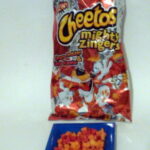The sight of the bag in the grocery store stymied me. Whatever could it mean? Natural Cheetos?
Did you ever see a Cheeto grazing in a pasture? Running wild through the woods? Climbing a tree? No! How about in a garden- a cheerful little Cheeto plant to be watered, weeded and coaxed into producing baby Cheetos? No!
What in the world is a Natural Cheeto, then? I was compelled to buy a bag to find out. And though my findings are inconclusive, I will share them here for the benefit of consumers hoping to learn more about Natural Cheetos.
Starting with a sneak peek in the Webster’s New Twentieth Century Dictionary, 2nd Ed., Simon & Schuster, p. 1197, to make sure my linguistic instincts were on track, sure enough I found a defintion for “natural:” “1. of, forming a part of, or arising from nature; 2. produced or existing in nature; real; not artificial or manufactured;[emphasis added; definition 3 omitted as irrelevant]; 4. (a) in a state provided by nature, without man-made changes; wild; uncultivated…[remaining definitions omitted as irrelevant] ”
So these Natural Cheetos were produced in nature or arose from it without manmade changes?
This required more detective work, starting with a close inspection of the ingredient panel on the back of the bag.
Natural Cheetos- the Ingredients
Organic Corn Meal
Expeller-pressed Sunflower Oil
Whey
Cheddar Cheese (Cultured Milk, Salt, Enzymes)
Maltodextrin
Sea Salt
Natural Flavors
Disodium Phosphate
Sour Cream (Cultured Skim Milk, Cream, Cornstarch, Nonfat Dry Milk)
Torula Yeast
Lactic Acid
Citric Acid
Disodium Phosphate? Look this up sometime if you like to scare yourself. It’s a stabilizer used in food processing. Natural food processing would be eating, would it not? So unless the manufacturer ate my Natural Cheetos before selling them to me (let’s not go there!), I am going to have to conclude that my Natural Cheetos were not naturally processed.
Manufacturers use disodium phosphate for enameling and metal treatment; as a buffer in the dyeing process; and in the production of pesticides, among other uses. Its toxicity oral rat LD50 is 17g/kg. In non-science speak that means half the rats in rat studies will drop dead after ingesting 17 grams of this stuff for each kilogram of their weight.
It’s inorganic- guess, the Frito Lay folks forgot to mention that on the label. They did mention that the corn meal was organic, after all.
And torula yeast, what’s that? According to Wikipedia, it’s a byproduct of paper production, made from wood sugars. Manufacturers use it to flavor processed foods and pet food.
So there are those advertised “natural flavors” and then this harmless looking stuff called a yeast. It’s used as a flavoring. It’s not covered by the “natural flavors” category, apparently. So why isn’t Frito Lay calling it an unnatural or artificial flavor?
There is one other detail, kind of a big one, that consumers need to know about tortula yeast. Torula yeast contains free glutamic acid, known to impair the normal functioning of the endocrine system and promote overeating- just like MSG and yeast extract, the “bad” ingredients torula yeast replaces when manufacturers decide to opt for “natural” labeling.
Nutrition Facts
The serving size for Natural Cheetos is listed as 1 oz. or about 32 pieces. Wonder if that’s before or after taking into account the slowdown of the endocrine system which causes the tendency to overeat? (Maybe I should eat these 32 Natural Cheetos really fast, just in case. )
If I succeed in limiting myself to a single serving (oops, I think I just surpassed it), I will have ingested:
9 g fat, 14% DV
1.5 g saturated fat, 7% DV
(Put those down, I told you!)
290 mg sodium, 12% DV
16 g carbohydrate, 5% DV
1g sugars
2 g protein
Let’s not kid ourselves into thinking that we are eating Natural Cheetos as a source of nutrients. (The Natural Cheetos have left the room; I’m safe now. Whew!) Natural Cheetos do contain some minimal nutrients, though, as well as 10% DV of Vitamin E.
Natural Cheetos Aesthetics
Evaluating the aesthetics of Natural Cheetos requires comparison to regular, or Unnatural, Cheetos. Unnatural Cheetos have a dastardly habit of turning hands and lips orange. Little orange crumbly stuff detaches from the Unnatural Cheeto on touch and sticks ferociously to fingers and any surfaces subsequently encountered by fingers.
Natural Cheetos by contrast are a creamy pale yellow color. Less crumbly stuff detaches, and it blends into most color schemes a bit more easily than that glaring orange.
Natural Cheetos Taste
Unfortunately, Natural Cheetos taste declicious! Mild cheese flavor, nice crunch. Still they do have that corn starch stickiness of the Unnatural Cheeto.
(Who am I kidding? Corn starch stickiness notwithstanding, if they were still sitting here next to me, I’d still be “taste testing” them.)
Natural Cheetos Price Competitiveness
An 8.5 ounce bag of Natural Cheetos cost $3.49 (impulse buy, no sale savings). This price was in line with similar “natural” snack foods.
Kid Evaluation
A 13 year old boy and a 10 year old girl both interjected themselves into the Natural Cheetos taste testing process. Both kids loved the taste. Neither kid expressed the least bit of concern over these Cheetos’ biological underpinnings.
If you should look out your window and spot a Cheeto frolicking in your front yard, please email me at once. Until then, my working hypothesis is that a Cheeto is not something found in nature.






